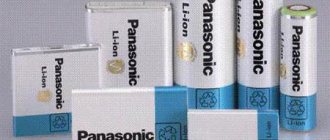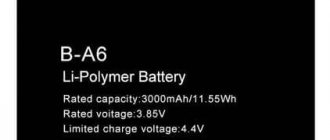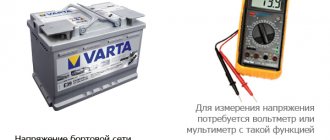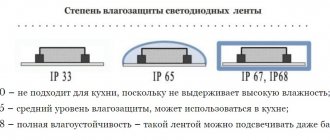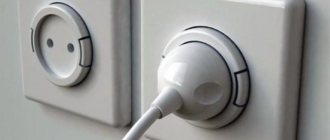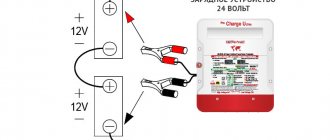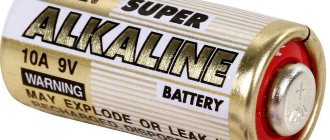Today, the basis for the functioning of many devices are rechargeable batteries, which are distinguished by their durability when compared with conventional ones. But this is not the only advantage that rechargeable batteries have; they can also be charged. This way you can save money on purchasing new ones. If used correctly, they can last for a long period of time.
Rechargeable batteries
If you do not adhere to the correct charging mode, you can shorten the life of the battery or completely kill it. How long does it take to charge a regular battery?
How long should batteries be charged and how should they be charged?
At the very beginning, you need to figure out how to properly recharge the battery. If it is not charged correctly, the service life will be significantly reduced.
You should first carefully read the instructions that come with the device. You can find the charging time in the instructions. But it may be that the instructions are missing. In this situation, it is necessary to use universal rules. Let's look at them in more detail:
- Battery charging time. How to calculate the charging time of an ordinary battery? If there is no information, then try to do the calculations yourself. Battery capacity required. It must be divided by the charging current, and at the end everything must be multiplied by 1.4. The result of these calculations is a number indicating the amount of charging time. Depending on the location of installation, there may be a different time value. Consumption in video cameras is higher when compared with cameras.
- Action with a new battery. To increase the service life to the maximum, a technological process called molding is carried out. It is necessary to fully charge the battery 3-4 times. Remember that immediately after purchase it must be completely discharged. After this, charging is carried out, which takes a sufficient amount of time. Under no circumstances should charging be interrupted. After fully charging, the device must be discharged again. This procedure has 3-4 repeated cycles.
- If it was not possible to calculate the charging time, then you need to focus on general values. General values are 10-14 hours. Checking for full charge is carried out as follows: you need to feel the surface of the device. If the surface is warm, then the battery can already be used.
Charging batteries
Safety precautions
In the process of preparing and charging the car battery, the following rules must be observed:
- charge the device in a well-ventilated area (garage, service station, or at least on the balcony);
- if there are small children in the family, you cannot exercise in the apartment;
- It is prohibited to smoke, set fire to anything or cut metal in the immediate vicinity of a charging battery;
- Do not charge the device in a room with high humidity;
- connect the terminals and clamps of the charger only when the charger is disconnected from the network;
- use safety glasses and gloves during work to prevent the dangerous effects of acid fumes;
- When working with a battery, keep a solution of 10% bicarbonate or sodium carbonate (soda) nearby.
A soda solution is suitable both for wiping the battery case from reagent fumes and for neutralizing acid in case of careless handling of the electrolyte
Additional Tips
Depending on the battery device, they may take different amounts of time to charge:
- An acid battery made of lead and used in a car is charged with a current of 0.1 of the rated value. The time is ten o'clock. If the capacity is 50 A/h, then a current of 5 A is required. The condition of the lead plates will not deteriorate from a full charge.
Lead acid battery
- Another type is nickel-cadmium batteries. Types: finger and little finger. For the charging procedure, chargers are used, which indicate the required current value. To determine the time, use the calculation method described above.
Nickel-cadmium batteries
- Polymer batteries made from lithium. The battery is charged using pulsed currents. Charge control is carried out using the charger processor. The time depends on the current. The time range is 30-60 minutes.
Lithium polymer batteries
The first two types of batteries must be fully charged. But the last type does not need to be charged; a full charge is murder for them.
Batteries
- It is possible and necessary
- 1. Before installing batteries, read the instructions supplied with the device.
- 2. Install batteries into the device correctly, observing the connection polarity (+) and (-).
- 3. Always fully charge batteries before use.
- 4. The first charge of batteries or their charge after long-term storage usually takes three hours. To maintain full battery capacity, it is recommended to completely discharge them first.
- 5. During charging, the batteries become warm; This is fine. Once fully charged, the batteries will gradually cool down to room temperature.
- 7. If you are not going to use an electrical device for a long time, remove the batteries from it.
- 8. Keep contact surfaces on batteries and contacts in battery compartments of devices clean; Whenever you replace batteries, wipe them with a clean pencil eraser or a rough cloth.
- 9. If the performance parameters of the batteries have decreased significantly, it is time to replace them.
- 10. Keep batteries away from children. If a battery is swallowed, seek medical attention immediately.
It is forbidden
- 1. Do not charge alkaline, carbon-zinc, lithium or other batteries that are not designed to be recharged, as they may leak or explode, causing injury or damage.
Charging methods
There are several methods by which you can charge the battery. Let's look at three ways to charge the battery:
- The device is charged using constant current. This method is the fastest.
- The device can be charged using constant voltage. You can apply varying voltage or constant voltage.
- The last method is combined. This method is divided into two stages. First you need to apply a constant current. The current value should be a tenth of the nominal value. When the voltage reaches 14.5 V, constant voltage is switched on. The second stage involves applying constant voltage. The current becomes less, so the internal resistance becomes greater.
The last method discussed is the most optimal if time is not the main factor. Gas formation and hydrolysis will be excluded. This occurs due to the supply of high voltage.
Do not forget that after the next recharge the battery life becomes worse. Nickel-cadmium batteries have only 1000 discharge/charge cycles.
Modern power components can have up to 3500-4000 discharge/charge cycles. How to use the battery correctly, read the technical documents and instructions. This article will also help you.
The service life of an ordinary average battery is three years or slightly less. Remember that devices cannot be recharged.
ReCyko+
- It is possible and necessary
- 1. New generation batteries are sold charged and have a low self-discharge rate, so they do not need to be charged before first use.
- 2. New generation batteries are sold charged and have a low self-discharge rate, so they are ready for use at any time.
- 3. Please read the operating instructions before installing batteries.
- 4. Install batteries into the device correctly, observing the connection polarity (+ and -).
- 5. During charging, batteries become warm. Once fully charged, the batteries will gradually cool down to room temperature.
- 6. Store batteries in a cool and dry place.
- 7. If you are not going to use the device for a long time, remove the batteries from it.
- 8. Keep contact surfaces on batteries clean; When replacing batteries, wipe them with a clean pencil eraser or dry cloth.
- 9. If the performance parameters of the batteries have deteriorated significantly, replace them.
- 10. Keep batteries out of the reach of children. If a battery is swallowed, seek medical attention immediately.
It is forbidden
- 1. Do not charge batteries of different capacities at the same time, unless the charger is equipped with individual charge channels.
To be honest, just recently, if you had asked me about charging batteries, I would have smiled and answered: “Did you mean batteries?” But, as it turned out, since 2011, a unique automatic charger ROBITON Ecocharger Ak01
allows you to charge not only NiMH/NiCD batteries, but also regular alkaline batteries.
I bring to your attention a test of this “eco-charging” and NiMH batteries ROBITON 2850MHAA
and
1100MHAAA
.
ROBITON
products entered the Russian market in 2003.
Now ROBITON
, according to the official website www.robiton.ru, occupies approximately 15% of the market in the “chargers for NiMH batteries” category.
In addition, ROBITON
specializes in the development and production of universal power supplies, batteries, surge protectors, timers, inverters, and testers.
All ROBITON
are certified in accordance with Russian and European quality standards.
* Input: 100-240 V AC 50/60 Hz * Output: - NiCD/NiMH AA/AAA 1.2 V DC x 1-4 pcs. 500± 20 mA - Alkaline AA/AAA 1.5 V DC x 1-4 pcs. 200± 20 mA * Low current trickle charge mode ≤100± 20 mA * No-load power consumption: ≤2 W * Full load power consumption: ≤7 W * Charge accumulation rate: ≥80% * Current error: ±20% The ROBITON Ecocharger Ak01
automatic charger is supplied in a transparent blister package that reliably protects against accidental damage.
There is a sticker on the package that draws the buyer’s attention to the unique charging function of AA/AAA alkaline batteries. The contents of the package consist of the bare minimum - a charger and user instructions. The model name Ecocharger
clearly indicates the ecological niche of the positioning of this charger. Well, how can we do without green in the design?
On the body of the charger there are 4 sockets for batteries of the most common sizes AA (the so-called “finger”) and AAA (“little finger”). Above each socket there is a two-color charging progress indicator. Its possible states: * constantly lit in red - the NiMH/NiCd battery is charging; * constantly lit green - the battery charging process is complete; * flashes alternately in red and green - the alkaline (alkaline) battery is charging; * constantly blinking red - the installed battery or battery is unusable.
The plug for connecting the charger to power outlets is located on the back of the case. Operation is possible in AC networks from 100 V to 240 V, which means operation in most countries of the world.
On the right side of the device there is a two-position switch for charging modes: alkaline (alkaline) batteries or NiMH/NiCD batteries.
ROBITON Ecocharger
is extremely easy to use; in fact, the mode of use comes down to choosing the type of batteries to be charged, and the “plug and forget” principle.
Popular battery chargers
To avoid mistakes when choosing a battery charger, we recommend chargers from well-known manufacturers. Today, the most popular devices among buyers are the following companies:
- LiitoKala - chargers from this manufacturer are not only of good quality, but also of low cost. Even in the middle price range you can purchase a universal transformerless charger equipped with a display.
- Varta - devices from a German manufacturer of electrical goods are distinguished by the highest quality and reliability. Even with long-term use of products from this company, no deviations in the operating mode are observed, and there is no loss of power when the capacity of large batteries is restored.
- Energizer - Has all the necessary qualities to award them first place in this rating, but the relatively high cost of the products does not allow this.
- Sititec is a manufacturer of high-quality electronic products, including solar chargers. The products are distinguished not only by their reliability, but also by their relatively low price.
- GP - devices for restoring the capacity of batteries from this manufacturer have a low price and good quality. Most of the company's products are produced for round batteries with a capacity of up to 2600 mA.
Products from any manufacturer from this list will allow you to easily restore the battery to its nominal capacity.
Still have questions or have something to add? Then write to us about it in the comments, this will make the material more useful, complete and accurate.



